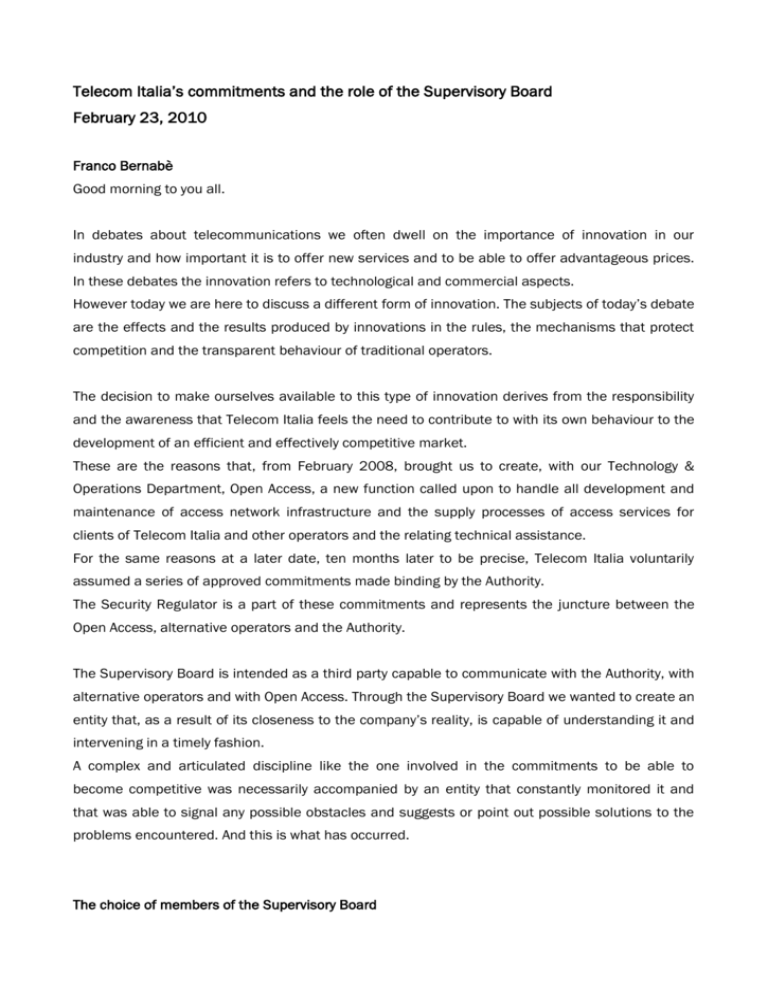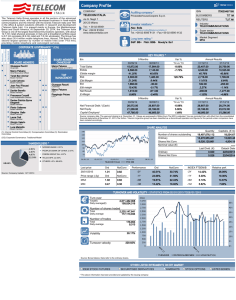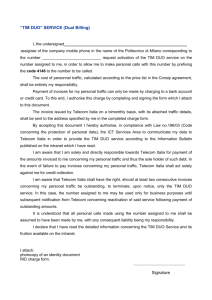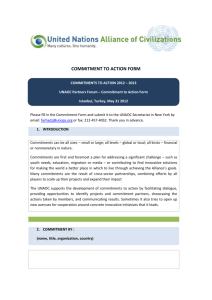Telecom Italia`s commitments and the role of the Supervisory Board
advertisement

Telecom Italia’s commitments and the role of the Supervisory Board February 23, 2010 Franco Bernabè Good morning to you all. In debates about telecommunications we often dwell on the importance of innovation in our industry and how important it is to offer new services and to be able to offer advantageous prices. In these debates the innovation refers to technological and commercial aspects. However today we are here to discuss a different form of innovation. The subjects of today’s debate are the effects and the results produced by innovations in the rules, the mechanisms that protect competition and the transparent behaviour of traditional operators. The decision to make ourselves available to this type of innovation derives from the responsibility and the awareness that Telecom Italia feels the need to contribute to with its own behaviour to the development of an efficient and effectively competitive market. These are the reasons that, from February 2008, brought us to create, with our Technology & Operations Department, Open Access, a new function called upon to handle all development and maintenance of access network infrastructure and the supply processes of access services for clients of Telecom Italia and other operators and the relating technical assistance. For the same reasons at a later date, ten months later to be precise, Telecom Italia voluntarily assumed a series of approved commitments made binding by the Authority. The Security Regulator is a part of these commitments and represents the juncture between the Open Access, alternative operators and the Authority. The Supervisory Board is intended as a third party capable to communicate with the Authority, with alternative operators and with Open Access. Through the Supervisory Board we wanted to create an entity that, as a result of its closeness to the company’s reality, is capable of understanding it and intervening in a timely fashion. A complex and articulated discipline like the one involved in the commitments to be able to become competitive was necessarily accompanied by an entity that constantly monitored it and that was able to signal any possible obstacles and suggests or point out possible solutions to the problems encountered. And this is what has occurred. The choice of members of the Supervisory Board Obviously in order to carry out such a technical and complete but at the same time delicate role it was necessary to find high profile individuals, institutionally and professionally, as well as individuals with a wealth of experience in the industry and a deep knowledge of specific topic from a juridical, technical and economic point of view. From the beginning however we were convinced that the selection of the right people in the right positions would be an essential factor for the success of the entire initiative. The credibility and effective independence of a collegial entity or an authority depend in fact, mainly, from the credibility, independence and seriousness of the professional route of its members, and we can also feel satisfied with the selection. Those we and the Authority invited to be a part of this new regulatory adventure, which is not devoid of its difficulties, accepted, men of the calibre of Giulio Napolitano, Francesco Chirichigno, Sergio Giovanni Fogli, Claudio Leporelli and Gerard Pogorel who apart from the wealth of academic and professional experience also have superb judgment. I believe the Supervisory Board is carrying out its takes with professionalism and competence, intervening decisively and firmly in situations where the commitments do not supply a specific solution to a certain problem. Our deepest thanks go to the members of the Supervisory Board for their efforts. Our thanks also go to the General Secretary and his staff for having carried out their duty in exemplary fashion. Furthermore it is with great satisfaction that I thank all our Telecom Italia colleagues that have worked hard and adopted the “spirit of the commitments” and have indentified innovative models and solutions. We must also give credit to the alternative operators, above all else, for having believed that the proposed solution could be utilized concretely and efficiently as a tool capable of improving the competitive mechanisms in the Italian market. If the commitments have become a reality, and the Supervisory Board has begun its task and this has allowed us, and will allow us in the future, to improve our service parameters, the credit is in part of the alternative operators. I am certain that this effort will allow us to reach excellent results as an industry and as an aid for the country’s productivity. Equal treatment and functional separation. There is no perfect model. Let us now move on to aspects related to the nature of the regulation. In debates we often compare different models which have been adopted in different countries and by different regulatory Authorities to assure effective internal-external equality in the treatment between the different commercial divisions of the traditional operators and the alternative operators. For starters the comparison is made with Openreach, the solution which was adopted in 2005 by the traditional English operator and the English Authority. The acknowledgement that the English regulator was the first to consider the problem of how to face the subject of equality of internalexternal treatment effectively is not entirely fair to AGCOM, who back in 2002 with Decree 152 was the first to introduce a range of rules and safeguards aimed at guaranteeing equal treatment. However I would like to highlight that, in my opinion, the debate concerning which is the best model is slightly sterile. There is no perfect model that covers all circumstances! Nor is there a model which should be slavishly imitated. Different models and different approaches exist, which adapt to the context they are adopted in, depending on geographical, temporal and market circumstances. The model adopted by OFCOM, which was created with the intention of remedying the unbundled development of the local network, which at the time was very limited, would not have been the ideal solution for countries like Germany, France or Italy where the unbundled access service market, already back in 2005, had reached a considerable size. The commitments underwritten by Telecom Italia are different in many aspects to the commitments underwritten by the traditional English operator. This however does not mean that they are better or worse than the English ones. They are simply different. The point I wish to make is that the models should not be judged on a comparison between different realities, but rather on the basis of how effective they are at resolving the problems they encounter and at overcoming the obstacles for which they were created. What can be done is a comparison between the objectives which the different models have been set for and the mode which has been adopted to reach those objectives. Telecom Italia’s commitments: a forward looking discipline, aimed at guaranteeing management efficiency of the process. I must point out two aspects regarding the differences between the English and the Italian solutions: the perspective temporal dimension and the importance given to the management nature, that is to the timeliness of the implementation of the commitments. With the inclusion of the commitments in the NGN the model adopted by AGCOM and Telecom Italia has proven to be a solution characterized by a strong prospective component. In the current national and European scenario, characterized by a great uncertainty in the regulatory frame, this opening to new generation networks is particularly useful, because it supplies certainties of sure value for those, like us and our competitors, who are taking their first steps in the land of the yet unexplored NGNs. In this regard I would also like to recall that with the underwriting of the commitments we have been able to anticipate the Directive 2009/140/CE (published in December 2009) by more than two years compared to its national level adoption. One of the main innovations mentioned in the directive is represented by the possibility given to the national Authority to accept the so called “voluntary separation” of the access network. In reality the European legislator, as well as introducing the institution of the “voluntary separation”, has also calculated that, following the adoption of this form of separation, the national Authorities must carry out a new analysis of the markets connected to the access network in order to reconsider and revaluate the need to maintain, modify or revoke previously imposed obligations. This clause, regarding the revisions of existing obligations following the introduction of separation measures, represents an explicit acknowledgement that measures of this type, according to the European legislator, can generate pro-competition effects that can re-open the discussion of the entire regulatory set-up in place before the separation. It is therefore clear that the process started by Telecom Italia with the voluntary presentation of the commitments relating to the access network and the deriving analysis of the access market by AGCOM have in fact anticipated the spirit of the new European regulations in regards to voluntary separation. I therefore believe that as a country system we can be satisfied for being pioneers in regulatory innovation. We now come to the operational-application aspects of the commitments. The operational solution chosen by Telecom Italia does not only respond to a simple need for equalization and “millimetre” equivalence of the activities carried out by the alternative operators compared to those carried out for the clients by the commercial division of Telecom Italia. The adopted solution, first of all, answers a need in the management and safeguarding of the efficiency of the operative processes. This choice has, in certain situations, helped in regards to the equivalence of output principle. The most important thing for us is the result. This is the philosophy that inspires us. If the performance indicators, which are monitored with absolute transparency and continuity by the Supervisory Board, show us that the performance of the supplied services is on average equal to those supplied by alternative operators (and in reality, in most cases, it is superior), it is clear that the fact that the procedures and systems adopted are not the same is less relevant. Of course in the long run we are heading towards an equalization of the processes; however this will occur naturally and gradually, coherently with the utility of the assets and systems. When the assets responsible for a certain function will need to be replaced we will move towards a unified solution, as much as possible. Had we taken a different approach, forcing the move to an immediate unification of the systems (which were created to treat significantly different volumes of traffic) we would have encountered a heavy burden of costs and an inevitable lengthening of time needed to implement the changes. The creation of Open Access has allowed us to manage and gather within the same division all the resources, activities and afferent assets of the access network and particularly the passive infrastructures of the latter. With the creation of Open Access we have first of all wanted to create an organizational structure that from an operational and technical point of view offered the best prospects of management performance and that was able to satisfy our needs, as a leading company that intends to supply quality services to its retail and wholesale clients. It is in a bid of maximizing efficiency that the underwriting of the commitments did not bring to an entire reorganization of the Open Access processes. In fact Telecom Italia, in order to fulfil the underwritten commitments, has simply created a parallel platform able to allow our competitors to offer the same services that we offer. This choice has allowed us to significantly reduce the amount of time needed to implement the network access separation model: in fact, the entirety of Telecom Italia’s commitments will be met within 15 months, therefore by the 31st of March, whilst the same commitments underwritten by British Telecom, in their initial form, were to take five years. The ownership of the investment choices There is one final aspect that is essential for us and upon which Telecom Italia will not compromise: the ownership of the decisions relating to investment (timing, architectural modes and technology). These decisions are, and must remain, the responsibility of the operator that invests its own capital and resources and which must answer to its own shareholders. The investment choices cannot and must not be influenced in any way by subjects that do not take part in the investment. Furthermore, to those who accuse us of not investing enough it is important to point out that the regulatory regime, through the use of very biased means, has sustained alternative operators for years, putting them in the condition to invest and to ascend the “ladder of investments”. This however has not occurred: no alternative access network has resulted from the biased measures. The evolution of the market has run its course and today we find ourselves with a single access network and this is a fact that we accept. What we cannot accept however is being accused of alleged poor quality of the access network by the same alternative operators that have benefited from advantageous unbundled access tariffs, of the good quality of the access network and its excellent technical characteristics. These criticisms, apart from not being true, are totally inappropriate and offensive. With equal strength we reject lessons on investment and considerations regarding an alleged lack of planned investments. Telecom Italia does not have an inferiority complex towards the other traditional European operators. Telecom Italia, which has a 15% relationship between domestic revenue and investment, invests more than other operators such as Telefónica (approximately 8%), France Telecom (approximately 8%) and Deutsche Telekom (approximately 12%). We have always invested an important share of our revenue, and we will continue to do so. According to what is set out in the commitments the alternative operators, as they did with the old networks, have the possibility of investing independently or alongside Telecom Italia (an offer to share the newly constructed infrastructure) and we hope that this will occur. In the Italian telecommunications market there are subjects whose dimensions and whose volume and financial availability are such to justify investments similar in size and extension to the ones Telecom Italia intends to realize. Those who claim that we do not invest enough in the new generation networks should remember that Telecom Italia is a company which has accumulated a wealth of experience in the field of telecommunications and that it has never missed a real opportunity to grow, in fact it has often known how to anticipate such opportunities. It is for that reason that as well as the NGN network developments in Milan and Rome, already included in our industrial plan, we have decided to also start a series of experimental initiatives of local scope that will allow us to deepen the real business opportunities offered by the new networks. Particularly the launch of a commercial offer in Milan and Rome will supply us with precious indications for the development of the new network in other areas and will allow us to review and improve our estimates regarding the development of demand for ultra wideband services. Furthermore we intend to share with AGCOM and the Supervisory Board, for a specific area, an experimental path aimed at completely substituting the copper wire network with an optic fiber network, in order to judge the effective cost reducing potential in the field. At the same time we are considering collaboration with other subjects. First of all, we are available to define the technical and financial terms and to underwrite agreements with other operators, respecting the antitrust discipline, to joint investment experiments solutions for the coverage of a medium sized city. Furthermore, we are open to evaluate proposals made by private subjects or institutions and public agencies that intend to invest in order to hasten the development of optic fibers in their area. In this regard we are particularly interested in the two study projects of the public administration of Trentino. The first foresees, through the use of the public administration’s infrastructure, the laying of optic fiber to reach 100% coverage of the plants that allow passage to full IP. The second project foresees the creation of a company through the Public Private Partnership formula for the laying of the optic fiber on the access network to connect the majority of the houses of the citizens and at the same time the disposal of the copper network. From the newborn company Telecom Italia would find itself buying, in equal amount to other operators, with regulated prices, the passive infrastructures to connect its clients in FTTH. We think that a model of this type would require a specific market analysis for the geographic area involved in order to evaluate the eventual elimination of the Telecom Italia obligations. Both projects would clearly require the involvement of AGCOM and the Supervisory Board. Finally we are equally interested in contributing to the development of an aimed program to accelerate the process of migration towards a fiber optic network in the city of Milan in view of the opportunities resulting from the 2015 EXPO. Conclusions With the creation of Open Access and the underwriting of the commitments Telecom Italia has favoured a concrete solution that is able to contain the time need and cost for implementation. The Open Access model represents an excellent compromise, capable of offering the right balance between past and future, between action timeliness and process equalization, between flexible principles and punctual monitoring. In the final analysis with Open Access and the underwriting of the commitments we have been able to guarantee the right equilibrium between the necessary guarantee of equal treatment, management efficiency and the preservation of the incentive to invest. Can the Open Access model be improved further? The answer is obviously yes. It is thanks to the continued communication with the Supervisory Board that I am sure we will be able to uphold our commitments in an ever more profitable and efficient way. If there is criticism of our efforts it is in our own interest to overcome them. Telecom Italia is open to dialogue and will do its best to meet the needs of alternative operators as long as these do not hinder the interests of our clients. This dialogue must occur and must occur through the predisposed bodies and venues. Every time the Supervisory Board has warned us of criticism we have intervened to remedy them. For this reason I would like to share with you the appreciation the Authority has recently made for the “effort appropriately put in place” that, according to the Authority, was made by our company “with the aim to respect not just the words of the commitments but also the spirit of those commitments”. This is honestly the best acknowledgement that could be made, because, I repeat once more, the commitments are not an exercise in innovation for the rules themselves. The commitments are a question of substance. The role that the five members of the Supervisory Board carry out, as I previous mentioned, is a new role both at domestic and international level and in order for such an innovative, complex and multi-faceted system of rules to work properly it needs time and a series of small improvements. We can say that this first year of implementation of our commitments has been, without a doubt, a break-in period for us, for the alternative operators, for the Supervisory Board itself and for the personnel assigned to its support. In order to find the best configuration and set-up even the Supervisory Board, like any other engine which has just left the factory, needs to be tested on the field. I therefore invite Telecom Italia personnel, the alternative operators and the authority to use the Supervisory Board not only when a problem or criticism presents itself, but also as a preemptive measure to identify solutions in a timely fashion to problems that might occur in the future. Finally I would like to leave you with something to reflect on: from what the Supervisory Board and the Authority have told us the Open Access solution, despite still being in its initial phase, seems to work, and to work well. Today the market, consumers and the country ask us to continue to operate in this direction and to allow the path undertaken to generate its fruits. And whilst at the beginning of my speech I praised the innovation of the rules as an essential component in the support of the development of an industry which is quickly evolving, it is also true that I am as convinced that an excess of “regulatory innovation” or overly rapid succession of “regulatory interventions” could harm the market. The economic subjects needed to plan one’s own future must operate in a stable and predictable regulatory context. This is what we are doing in Telecom Italia: we are planning our safe future that the solutions adopted with AGCOM guarantee the development of a competitive market in which all subjects are capable of investing in the new networks in completely equal circumstances. The commitments underwritten have improved the external perception our competitors and the institutions have in our regards, and we are happy of this. In order for the telecommunications market to prosper it requires clarity and transparency. With the creation of the Supervisory Board we have certainly taken an important step forward in this direction; however it is important to stay the course. Today the new generation networks will develop in a well structured and competitive market, exactly like the mobile phone networks, our competitors have reached an important dimension and are part of groups which have established themselves on a global level. The Italian market, after more than a decade of efficient regulation, a healthy consolidation and a clear form of protection and the well underway equality of treatment, has all the requirements to prosper and become a competitive and lucrative NGN market. In order to seize this opportunity however we must allow the market mechanisms to function. If we do then I am certain that the network market and the new generation Italian service market will have nothing to envy from other primary European markets, instead it will be an example to follow, just as we are for the “regulatory innovations”. Thank you for your attention.







